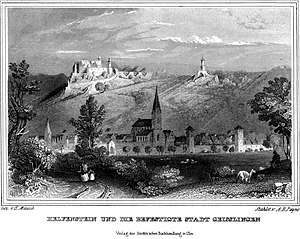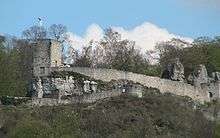Helfenstein Castle
Helfenstein Castle represents the remnants of the fortified castle (burg) Helfenstein of the counts of Helfenstein located above the city of Geislingen an der Steige, Baden-Württemberg, Germany.

History

The castle was constructed, by Eberhard von Helfenstein, at the turn of the 12th century and was frequently enlarged during the period from 1100 to 1380. The site of the castle, over the main Imperial road through the Fils valley, allowed the Helfensteins to observe and control trade in the region.[1] The close connection between the Helfensteins and the Hohenstaufen Emperors during the 12th and 13th Centuries allowed the family to grow and expand. During the peak of their power the Helfenstein family ruled Heidenheim, Blaubeuren, Wiesensteig and Sigmaringen. However, as the Hohenstaufen family lost power so did the Helfensteins. By 1382 the castle was used as collateral for a loan from the city of Ulm. Then in 1396 the castle was totally under the control of the free and imperial city of Ulm.
As gunpowder weapons became more common, the castle was expanded and rebuilt as a fortress. On the top of the hill, in the direction of Weiler, a bulwark was built to protect the castle. The old keep was rebuilt with extensive walls. Additionally, the terraces below the castle were expanded and fortified. The castle was used for the Ulm representative or Vogt and the western section of the castle was rebuilt as proper home for a patrician Vogt.
In 1552, during the Second Margrave War the castle fell unopposed into the hands of the Margrave of Brandenburg-Kulmbach. In August that year, troops from Ulm retook the castle after several days of shelling with heavy stone cannonballs. Having lost its significance and value as a fortification, the city of Ulm started to demolish the castle starting in 1552, sending all usable materials to Ulm. The ruins were left and the site became overgrown over the following centuries.
Starting in 1932, the site of Helfenstein Castle was excavated with the help of Army engineer troops. A south tower was rebuilt and stairs and wooden bridges were erected to allow easy access from several directions. The ruined complex is a favorite destination for weekend walks and excursions.
References
- Dörr (1988). Schwäbische Alb: Bergen, Schlösser, Ruinen. Schwäbisch-Hall, Germany: E. Schwend GmbH & Co. pp. 21–23. ISBN 3-616-06727-8.
External links
- Ruine Helfenstein on Bergen Inventar.de (in German)
- Ruine Helfenstein on Bergenwelt.de (in German)
